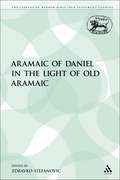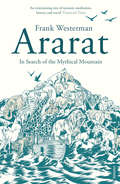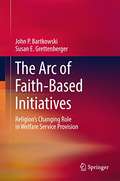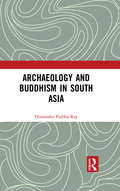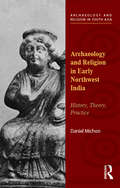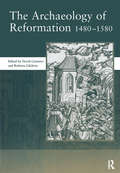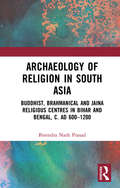- Table View
- List View
The Aramaic of Daniel in the Light of Old Aramaic (The Library of Hebrew Bible/Old Testament Studies)
by Zdravko StefanovicThe author examines a number of the published Old Aramaic inscriptions, and compares them with the Aramaic of Daniel according to a broad-based set of criteria; detailed literary, grammatical and lexicographical comparisons build a cumulative case for questioning both the unified character of Old Aramaic and the supposedly late character of numerous features in Old Aramaic. The author thus contributes to the discussion of whether Old Aramaic texts can be used for understanding the Aramaic of Daniel, on the one hand, while contributing to an evaluation of the debate concerning the origin of the Aramaic of Daniel on the other.
Ararat: In Search of the Mythical Mountain
by Frank WestermanMount Ararat in Turkey is where, as biblical tradition has it, Noah's Ark ran aground and God made his covenant with mankind. Now it stands astride the fault-line between religion and science, a geographical, political and cultural crossroads, bound up with the centuries-old history of warfare between different cultures in this region. Frank Westerman takes a pilgrimage from the mountain's foot to its highest slopes, meeting along the way geologists, priests and an expedition in search of the Ark's remains, as well as a Russian astronaut who observes that 'there is something between heaven and earth about which we humans know nothing'. Ararat is a dazzling, highly personal book about science, religion and all that lies between, by one of Europe's most celebrated young writers.
Arbeit als Subjektivierendes Handeln: Handlungsfähigkeit bei Unwägbarkeiten und Ungewissheit
by Fritz BoehleDieses Buch zeigt, dass menschliche Fähigkeiten wie subjektives Empfinden und Gespür, assoziativ-bildhaftes Denken und situatives Vorgehen notwendig sind, um Ziele zu erreichen und Probleme zu lösen. Dies ist gerade auch im Arbeitsbereich, in dem das Leitbild planmäßig-rationalen Handelns vorherrscht, der Fall. Insbesondere in unwägbaren und ungewissen Situationen sind solche Fähigkeiten unverzichtbar und gewährleisten Handlungsfähigkeit. Sie führen in ihrem Zusammenhang und Zusammenwirken zu einer eigenständigen Handlungsweise und Handlungslogik. Dies wird mit dem Konzept des „subjektivierenden Handelns“ systematisch erfasst und begründet. Dieses handlungstheoretische Konzept geht über den bloßen Verweis auf bounded rationality, Intuition, Bauchgefühl oder Improvisation hinaus und zeigt, dass intentionales Handeln auf einem objektivierenden und subjektivierenden Handeln beruht.
Arbeit und Freiheit: Eine Paradoxie der Moderne (essentials)
by Hans-Jürgen ArltIn diesem essential beschreibt Hans-Jürgen Arlt das Paradox unserer modernen Gesellschaft, die Freiheit als ihren höchsten Wert feiert und verteidigt, aber mit der Arbeitstätigkeit eine Lebenspraxis in ihr Zentrum stellt, die in der Regel unfreiwillig und fremdbestimmt ausgeübt wird. Dieses Paradox nimmt das essential zum Anlass aufzuzeigen, wie die Moderne in die Arbeitsgesellschaft hineingeriet und wie sie herauskommen kann. Der Arbeit ohne Ende mit Wachstumszwang, Konsumsucht und sozialer Spaltung wird ein Szenario gegenüber gestellt, das die Kollektivität der Arbeit mit individuellen Freiheitsrechten versöhnt. Statt auf das Recht des Stärkeren oder die Verstaatlichung der Arbeit zu setzen, wird für ein Freiheitsverständnis plädiert, dem es auf das reflektierte Verhältnis von Bindung und Unabhängigkeit ankommt. Skizziert wird eine Wirtschaftsweise, die besser zu leben und weniger zu arbeiten als egalitäres, nicht nur als elitäres Programm realisiert.
Arboreal Symbolism in European Art, 1300–1800 (Routledge Research in Art and Religion)
by Katherine T. BrownArboreal Symbolism in European Art, 1300–1800 probes the significance of trees in religious iconography of Western art.Based in the disciplines of art history, botany, and theology, this study focuses on selected works of art in which tree forms embody and reflect Christian themes. Through this triple lens, Brown examines trees that early modern artists rendered as sacred symbols—symbols with origins in the Old Testament, New Testament, Greek and Roman cultures, and early medieval legends. Tree components and wood depicted in works of art can serve as evidence for early modern artists’ embrace of biblical metaphor, classical sources, and devotional connotations. The author considers how artists rendered seasonal change in Christian narratives to emphasize themes of spiritual transformation. Brown argues that many artists and their patrons drew parallels between the life cycle of a tree and events in the Gospels with their respective annual, liturgical celebrations.This book will interest scholars in art history, religion, humanities, and interdisciplinary studies.
Arboreal Symbolism in European Art, 1300–1800 (Routledge Research in Art and Religion)
by Katherine T. BrownArboreal Symbolism in European Art, 1300–1800 probes the significance of trees in religious iconography of Western art.Based in the disciplines of art history, botany, and theology, this study focuses on selected works of art in which tree forms embody and reflect Christian themes. Through this triple lens, Brown examines trees that early modern artists rendered as sacred symbols—symbols with origins in the Old Testament, New Testament, Greek and Roman cultures, and early medieval legends. Tree components and wood depicted in works of art can serve as evidence for early modern artists’ embrace of biblical metaphor, classical sources, and devotional connotations. The author considers how artists rendered seasonal change in Christian narratives to emphasize themes of spiritual transformation. Brown argues that many artists and their patrons drew parallels between the life cycle of a tree and events in the Gospels with their respective annual, liturgical celebrations.This book will interest scholars in art history, religion, humanities, and interdisciplinary studies.
The Arc of Faith-Based Initiatives: Religion’s Changing Role in Welfare Service Provision
by John P. Bartkowski Susan E. GrettenbergerThis volume offers an in-depth examination of a diverse range of faith-based programs implemented in three different geographical locales: family support in rural Mississippi, transitional housing in Michigan, and addiction recovery in the Pacific Northwest (Washington-Oregon). Various types of religious service providers—faith-intensive and faith-related—are carefully examined, and secular organizations also serve as an illuminating point of comparison. Among other insights, this book reveals how the “three C’s” of social service provision—programmatic content, organizational culture, and ecological context—all combine to shape the delivery of welfare services in the nonprofit world. This book warns against simplistic generalizations about faith-based organizations. Faith-based providers exhibit considerable diversity and, quite often, remarkable resilience in the face of challenging social circumstances. An appreciation of these nuances is critical as policies concerning faith-based organizations continue to evolve.
An Archaeological History of Indian Buddhism
by Lars FogelinAn Archaeological History of Indian Buddhism is a comprehensive survey of Indian Buddhism from its origins in the 6th century BCE, through its ascendance in the 1st millennium CE, and its eventual decline in mainland South Asia by the mid-2nd millennium CE. Weaving together studies of archaeological remains, architecture, iconography, inscriptions, and Buddhist historical sources, this book uncovers the quotidian concerns and practices of Buddhist monks and nuns (the sangha), and their lay adherents--concerns and practices often obscured in studies of Buddhism premised largely, if not exclusively, on Buddhist texts. At the heart of Indian Buddhism lies a persistent social contradiction between the desire for individual asceticism versus the need to maintain a coherent community of Buddhists. Before the early 1st millennium CE, the sangha relied heavily on the patronage of kings, guilds, and ordinary Buddhists to support themselves. During this period, the sangha emphasized the communal elements of Buddhism as they sought to establish themselves as the leaders of a coherent religious order. By the mid-1st millennium CE, Buddhist monasteries had become powerful political and economic institutions with extensive landholdings and wealth. This new economic self-sufficiency allowed the sangha to limit their day-to-day interaction with the laity and begin to more fully satisfy their ascetic desires for the first time. This withdrawal from regular interaction with the laity led to the collapse of Buddhism in India in the early-to-mid 2nd millennium CE. In contrast to the ever-changing religious practices of the Buddhist sangha, the Buddhist laity were more conservative--maintaining their religious practices for almost two millennia, even as they nominally shifted their allegiances to rival religious orders. This book also serves as an exemplar for the archaeological study of long-term religious change through the perspectives of practice theory, materiality, and semiotics.
An Archaeological History of Indian Buddhism
by Lars FogelinAn Archaeological History of Indian Buddhism is a comprehensive survey of Indian Buddhism from its origins in the 6th century BCE, through its ascendance in the 1st millennium CE, and its eventual decline in mainland South Asia by the mid-2nd millennium CE. Weaving together studies of archaeological remains, architecture, iconography, inscriptions, and Buddhist historical sources, this book uncovers the quotidian concerns and practices of Buddhist monks and nuns (the sangha), and their lay adherents--concerns and practices often obscured in studies of Buddhism premised largely, if not exclusively, on Buddhist texts. At the heart of Indian Buddhism lies a persistent social contradiction between the desire for individual asceticism versus the need to maintain a coherent community of Buddhists. Before the early 1st millennium CE, the sangha relied heavily on the patronage of kings, guilds, and ordinary Buddhists to support themselves. During this period, the sangha emphasized the communal elements of Buddhism as they sought to establish themselves as the leaders of a coherent religious order. By the mid-1st millennium CE, Buddhist monasteries had become powerful political and economic institutions with extensive landholdings and wealth. This new economic self-sufficiency allowed the sangha to limit their day-to-day interaction with the laity and begin to more fully satisfy their ascetic desires for the first time. This withdrawal from regular interaction with the laity led to the collapse of Buddhism in India in the early-to-mid 2nd millennium CE. In contrast to the ever-changing religious practices of the Buddhist sangha, the Buddhist laity were more conservative--maintaining their religious practices for almost two millennia, even as they nominally shifted their allegiances to rival religious orders. This book also serves as an exemplar for the archaeological study of long-term religious change through the perspectives of practice theory, materiality, and semiotics.
Archaeology and Buddhism in South Asia
by Himanshu Prabha RayThis book traces the archaeological trajectory of the expansion of Buddhism and its regional variations in South Asia. Focusing on the multireligious context of the subcontinent in the first millennium BCE, the volume breaks from conventional studies that pose Buddhism as a counter to the Vedic tradition to understanding the religion more integrally in terms of dhamma (teachings of the Buddha), dāna (practice of cultivating generosity) and the engagement with the written word. The work underlines that relic and image worship were important features in the spread of Buddhism in the region and were instrumental in bringing the monastics and the laity together. Further, the author examines the significance of the histories of monastic complexes (viharas, stupas, caityas) and also religious travel and pilgrimage that provided connections across the subcontinent and the seas. An interdisciplinary study, this book will be of great interest to students and scholars in South Asian studies, religion, especially Buddhist studies, history and archaeology.
Archaeology and Buddhism in South Asia: An Archaeology Of Museum Collections (Archaeology And Religion In South Asia Ser.)
by Himanshu Prabha RayThis book traces the archaeological trajectory of the expansion of Buddhism and its regional variations in South Asia. Focusing on the multireligious context of the subcontinent in the first millennium BCE, the volume breaks from conventional studies that pose Buddhism as a counter to the Vedic tradition to understanding the religion more integrally in terms of dhamma (teachings of the Buddha), dāna (practice of cultivating generosity) and the engagement with the written word. The work underlines that relic and image worship were important features in the spread of Buddhism in the region and were instrumental in bringing the monastics and the laity together. Further, the author examines the significance of the histories of monastic complexes (viharas, stupas, caityas) and also religious travel and pilgrimage that provided connections across the subcontinent and the seas. An interdisciplinary study, this book will be of great interest to students and scholars in South Asian studies, religion, especially Buddhist studies, history and archaeology.
Archaeology and Religion in Early Northwest India: History, Theory, Practice (Archaeology and Religion in South Asia)
by Daniel MichonThis book explores the ways in which past cultures have been used to shape colonial and postcolonial cultural identities. It provides a theoretical framework to understand these processes, and offers illustrative case studies in which the agency of ancient peoples, rather than the desires of antiquarians and archaeologists, is brought to the fore.
Archaeology and Religion in Early Northwest India: History, Theory, Practice (Archaeology and Religion in South Asia)
by Daniel MichonThis book explores the ways in which past cultures have been used to shape colonial and postcolonial cultural identities. It provides a theoretical framework to understand these processes, and offers illustrative case studies in which the agency of ancient peoples, rather than the desires of antiquarians and archaeologists, is brought to the fore.
Archaeology and the Letters of Paul
by Laura Salah NasrallahArchaeology and the Letters of Paul illuminates the social, political, economic, and religious lives of those to whom the apostle Paul wrote. Roman Ephesos provides evidence of slave traders and the regulation of slaves; it is a likely setting for household of Philemon, to whom a letter about the slave Onesimus is addressed. In Galatia, an inscription seeks to restrain the demands of travelling Roman officials, illuminating how the apostolic travels of Paul, Cephas, and others disrupted communities. At Philippi, a list of donations from the cult of Silvanus demonstrates the benefactions of a community that, like those in Christ, sought to share abundance in the midst of economic limitations. In Corinth, a landscape of grief extends from monuments to the bones of the dead, and provides a context in which to understand Corinthian practices of baptism on behalf of the dead and the provocative idea that one could live"as if not" mourning or rejoicing. Rome and the Letter to the Romans are the grounds for an investigation of ideas of time and race not only in the first century, when we find an Egyptian obelisk inserted as a timepiece into the mausoleum complex of Augustus, but also of a new Rome under Mussolini that claimed the continuity of Roman racial identity from antiquity to his time and sought to excise Jews. Thessalonikē and the early Christian literature associated with the city demonstrates what is done out of love for Paul-invention of letters, legends, and cult in his name. The book articulates a method for bringing together biblical texts with archaeological remains. This method reconstructs the lives of the many adelphoi—brothers and sisters—whom Paul and his co-writers address. Its project is informed by feminist historiography and gains inspiration from thinkers such as Claudia Rankine, Judith Butler, Giorgio Agamben, Wendy Brown, and Katie Lofton.
Archaeology and the Letters of Paul
by Laura Salah NasrallahArchaeology and the Letters of Paul illuminates the social, political, economic, and religious lives of those to whom the apostle Paul wrote. Roman Ephesos provides evidence of slave traders and the regulation of slaves; it is a likely setting for household of Philemon, to whom a letter about the slave Onesimus is addressed. In Galatia, an inscription seeks to restrain the demands of travelling Roman officials, illuminating how the apostolic travels of Paul, Cephas, and others disrupted communities. At Philippi, a list of donations from the cult of Silvanus demonstrates the benefactions of a community that, like those in Christ, sought to share abundance in the midst of economic limitations. In Corinth, a landscape of grief extends from monuments to the bones of the dead, and provides a context in which to understand Corinthian practices of baptism on behalf of the dead and the provocative idea that one could live"as if not" mourning or rejoicing. Rome and the Letter to the Romans are the grounds for an investigation of ideas of time and race not only in the first century, when we find an Egyptian obelisk inserted as a timepiece into the mausoleum complex of Augustus, but also of a new Rome under Mussolini that claimed the continuity of Roman racial identity from antiquity to his time and sought to excise Jews. Thessalonikē and the early Christian literature associated with the city demonstrates what is done out of love for Paul-invention of letters, legends, and cult in his name. The book articulates a method for bringing together biblical texts with archaeological remains. This method reconstructs the lives of the many adelphoi—brothers and sisters—whom Paul and his co-writers address. Its project is informed by feminist historiography and gains inspiration from thinkers such as Claudia Rankine, Judith Butler, Giorgio Agamben, Wendy Brown, and Katie Lofton.
Archaeology and the Old Testament (PDF)
by James B. PritchardArchaeology is a science in which progress can be measured by the advances made backward into the past. The last one hundred years of archaeology have added a score of centuries to the story of the growth of our cultural and religious heritage, as the ancient world has been recovered from the sands and caves of the modern Near East-Egypt, Jordan, Israel, Syria, Lebanon, Turkey, and Iraq. Measured by the number of centuries which have been annexed to man's history in a relatively few years, progress has been truly phenomenal. This book deals with the recent advance and with those pioneers to the past who made it possible. Interest in biblical history has played an important part in this recovery. Names such as Babylon, Nineveh, Jericho, Jerusalem, and others prominent on the pages of the Bible, have gripped the popular imagination and worked like magic to gain support for excavations.This book is written from the widely shared conviction that the discovery of the ancient Near East has shed significant light on the Bible. Indeed, the newly-discovered ancient world has effected a revolution in the understanding of the Bible, its people, and their history. My purpose is to assess, in non-technical language which the layman can understand, the kind of change in viewing the biblical past which archaeology has brought about in the last century. Since the text of the Bible has remained constant over this period, it is obvious that any new light on its meaning must provide a better perspective for seeing the events which it describes. In short, I am concerned with the question, How has history as written in the Bible been changed, enlarged, or substantiated by the past century of the archaeological work?--from the Preface
The Archaeology of Israel: Constructing the Past, Interpreting the Present (The Library of Hebrew Bible/Old Testament Studies)
by Neil Asher Silberman David B. SmallThis challenging volume offers a timely and extensive overview of the current state of archaeology in Israel. Contributed by leading scholars, the essays focus on current problems and cutting-edge issues, ranging from reviews of ongoing excavations to new analytical approaches. Of interest not only to archaeologists, but to social historians as well, the topics include archaeology and social history, archaeology and ethnicity, as well as the overarching issue of how texts and archaeological knowledge are to be combined in the reconstruction of ancient Israel.
Archaeology of Jesus' Nazareth
by Ken DarkArchaeology of Jesus' Nazareth is the first book on the archaeology of first-century Nazareth: Jesus' hometown in Galilee. Requiring no previous knowledge of biblical history or archaeology, it outlines the latest archaeological evidence, placing the Gospels' account of Jesus' youth in the Bible, and origins of Christian pilgrimage, in a new context. The book concentrates on the fascinating Sisters of Nazareth site in the centre of the present city. There, twenty-first century archaeological research identified a Byzantine pilgrimage church, which is likely to be the Church of the Nutrition - dedicated to the upbringing of Christ - the most important previously 'lost' early Christian church in the Holy Land. A seventh-century pilgrim said that a vaulted area under the Church of the Nutrition contained the actual house where Jesus was brought up by Mary and Joseph. Intriguingly, below the Byzantine church at the Sisters of Nazareth site a vaulted area preserved what are probably the ruins of a first-century house. Even before the Byzantine church was built, a - probably fourth-century - cave-church was constructed next to the first-century ruins, suggesting that they were assigned Christian religious importance. The similarities with the pilgrim's description raise the question of whether the Sisters of Nazareth house really could have been the childhood home of Jesus. The book draws to its conclusion by means of a discussion of this historical existence for Jesus and the implications of the archaeology of Nazareth for understanding the Gospels.
Archaeology of Jesus' Nazareth
by Ken DarkArchaeology of Jesus' Nazareth is the first book on the archaeology of first-century Nazareth: Jesus' hometown in Galilee. Requiring no previous knowledge of biblical history or archaeology, it outlines the latest archaeological evidence, placing the Gospels' account of Jesus' youth in the Bible, and origins of Christian pilgrimage, in a new context. The book concentrates on the fascinating Sisters of Nazareth site in the centre of the present city. There, twenty-first century archaeological research identified a Byzantine pilgrimage church, which is likely to be the Church of the Nutrition - dedicated to the upbringing of Christ - the most important previously 'lost' early Christian church in the Holy Land. A seventh-century pilgrim said that a vaulted area under the Church of the Nutrition contained the actual house where Jesus was brought up by Mary and Joseph. Intriguingly, below the Byzantine church at the Sisters of Nazareth site a vaulted area preserved what are probably the ruins of a first-century house. Even before the Byzantine church was built, a - probably fourth-century - cave-church was constructed next to the first-century ruins, suggesting that they were assigned Christian religious importance. The similarities with the pilgrim's description raise the question of whether the Sisters of Nazareth house really could have been the childhood home of Jesus. The book draws to its conclusion by means of a discussion of this historical existence for Jesus and the implications of the archaeology of Nazareth for understanding the Gospels.
The Archaeology of Reformation,1480-1580
by David GaimsterTraditionally the Reformation has been viewed as responsible for the rupture of the medieval order and the foundation of modern society. Recently historians have challenged the stereotypical model of cataclysm, and demonstrated that the religion of Tudor England was full of both continuities and adaptations of traditional liturgy, ritual and devoti
The Archaeology of Reformation,1480-1580
by David GaimsterTraditionally the Reformation has been viewed as responsible for the rupture of the medieval order and the foundation of modern society. Recently historians have challenged the stereotypical model of cataclysm, and demonstrated that the religion of Tudor England was full of both continuities and adaptations of traditional liturgy, ritual and devoti
Archaeology of Religion in South Asia: Buddhist, Brahmanical and Jaina Religious Centres in Bihar and Bengal, c. AD 600–1200
by Birendra Nath PrasadIn the religious landscape of early medieval (c. AD 600-1200) Bihar and Bengal, poly-religiosity was generally the norm than an exception, which entailed the evolution of complex patterns of inter-religious equations. Buddhism, Brahmanism and Jainism not only coexisted but also competed for social patronage, forcing them to enter into complex interactions with social institutions and processes. Through an analysis of the published archaeological data, this work explores some aspects of the social history of Buddhist, Brahmanical and Jaina temples and shrines, and Buddhist stūpas and monasteries in early medieval Bihar and Bengal. This archaeological history of religions questions many ‘established’ textual reconstructions, and enriches our understanding of the complex issue of the decline of Buddhism in this area. Please note: Taylor & Francis does not sell or distribute the Hardback in India, Pakistan, Nepal, Bhutan, Bangladesh and Sri Lanka.
Archaeology of Religion in South Asia: Buddhist, Brahmanical and Jaina Religious Centres in Bihar and Bengal, c. AD 600–1200
by Birendra Nath PrasadIn the religious landscape of early medieval (c. AD 600-1200) Bihar and Bengal, poly-religiosity was generally the norm than an exception, which entailed the evolution of complex patterns of inter-religious equations. Buddhism, Brahmanism and Jainism not only coexisted but also competed for social patronage, forcing them to enter into complex interactions with social institutions and processes. Through an analysis of the published archaeological data, this work explores some aspects of the social history of Buddhist, Brahmanical and Jaina temples and shrines, and Buddhist stūpas and monasteries in early medieval Bihar and Bengal. This archaeological history of religions questions many ‘established’ textual reconstructions, and enriches our understanding of the complex issue of the decline of Buddhism in this area. Please note: Taylor & Francis does not sell or distribute the Hardback in India, Pakistan, Nepal, Bhutan, Bangladesh and Sri Lanka.
The Archaeology of Sacred Spaces: The temple in western India, 2nd century BCE–8th century CE (Archaeology and Religion in South Asia)
by Susan Verma Mishra Himanshu Prabha RayThis volume focuses on the religious shrine in western India as an institution of cultural integration in the period spanning 200 BCE to 800 CE. It presents an analysis of religious architecture at multiple levels, both temporal and spatial, and distinguishes it as a ritual instrument that integrates individuals and communities into a cultural fabric. The work shows how these structures emphasise on communication with a host of audiences such as the lay worshipper, the ritual specialist, the royalty and the elite as well as the artisan and the sculptor. It also examines religious imagery, inscriptions, traditional lore and Sanskrit literature. The book will be of special interest to researchers and scholars of ancient Indian history, Hinduism, religious studies, architecture and South Asian studies.
The Archaeology of Sacred Spaces: The temple in western India, 2nd century BCE–8th century CE (Archaeology and Religion in South Asia)
by Susan Verma Mishra Himanshu Prabha RayThis volume focuses on the religious shrine in western India as an institution of cultural integration in the period spanning 200 BCE to 800 CE. It presents an analysis of religious architecture at multiple levels, both temporal and spatial, and distinguishes it as a ritual instrument that integrates individuals and communities into a cultural fabric. The work shows how these structures emphasise on communication with a host of audiences such as the lay worshipper, the ritual specialist, the royalty and the elite as well as the artisan and the sculptor. It also examines religious imagery, inscriptions, traditional lore and Sanskrit literature. The book will be of special interest to researchers and scholars of ancient Indian history, Hinduism, religious studies, architecture and South Asian studies.
